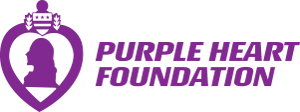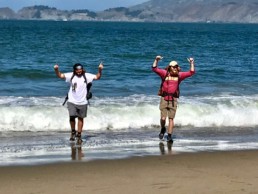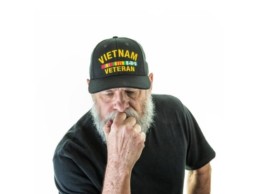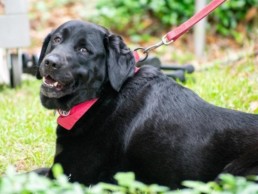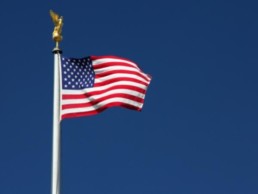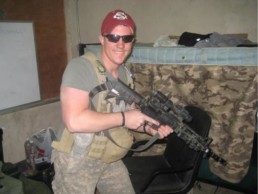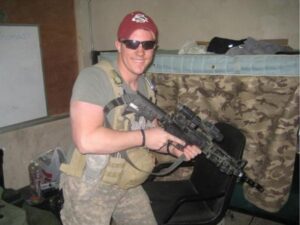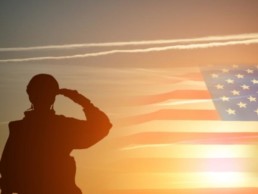A Look Back At Their Walk Across America
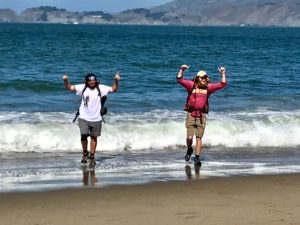
Back in 2018, two friends, Matt Andersen & Trevor Stephens, began their journey, a “Walk Across America,” that would take a little over 6 months to raise awareness and money for a charity of their choosing. They chose that they would be walking for the Purple Heart Foundation in May 2018. They showed the power of what two people can do for the veteran community. Matt and Trevor were able to raise over $8,000 for the Purple Heart Foundation during their walk. We caught up with them to talk more in-depth about their “Walk Across America” and what they have been up to.
Thank you gentleman for taking some time to sit down and talk with us to catch up.
(Matt & Trevor): Thanks for having us. We are happy to be here talking with our friends from the Purple Heart Foundation.
Trevor, you are a veteran. How do you look back on your days on active duty?
(Trevor): Kinda like the walk, at the time it was a tough and frustrating time, and there was a lot of bad but looking back it was some of the best times of my life. It impacted me in a way that got me out of trouble. I truly believed it helped me in life in different ways.
I have a friend actually who was helped by the Purple Heart Foundation with a grant around the time we began the walk. He is doing much better and is walking with a cane. He regained most of walking with a cane. He can’t work but still does therapy and lives in North Carolina. He has a good mental mindset, he still makes jokes and has a good attitude.
Does your status as a veteran prompt you to talk about issues like veteran suicides?
(Trevor): It is important because I know a few people in connections that know others that have committed suicide. When you are in the military you know how big of a deal it is. Going through tough situations sometimes you break. There is a lot of stress so it's important to let everyone know about what is going on with our veterans.
You two are good friends from Council Bluffs, IA, but how did the walk Across America get started?
(Matt): In 2007 we met each other in middle school in Iowa. In High school we became closer friends through mutual friendships. It was Trevor's idea to do it. The road trip was scheduled after I graduated from college and Trevor came out of military duty. Trevor was watching videos of people walking long distances for music festivals in a show.
(Trevor): Going through a rabbit hole and seeing what others did to raise money for charity, I got the idea of walking across the country. I texted another friend if he wanted to walk across the country. I was not doing it by myself and texted Matt. At first he thought I was crazy. It took some convincing for Matt to finally get him to join the walk. We had brought up the idea of traveling before. Took him an hour to be set to want to do it, then 4th of July 2017 it was decided that we were going to do it.
"This is where it felt like it became bigger than us.”
It has been a little while since you did the Walk Across America, how did you both feel about doing it in the beginning? How do you feel about it now?
(Trevor): It was hard to believe that we actually did it in the end. I go back and rewatch the videos they made along the way. It was 7 months worth of videos on the road. I look back on it and it was one of the best things I have done in my life, along with joining the marine corps.
Are there any memories from the trip that stick out to you guys?
(Matt): From all kinds of people we met along the way. People took us in to have us as guests in their homes when they understood that we were supporting veterans and the Purple Heart Foundation. We met a man in Walcott, Iowa, stopped on the road when he saw us, went down the street, got food for us and came back. We ate the food in his truck. He gave us a signed book since he was a writer. I see a town somewhere and I remember and say wow I really walked through that place. People were always stopping to see us and ask what we were doing. And they loved the idea as soon as they found out and were supportive. One couple invited us to eat at a restaurant and let us stay in their home to sleep over. The Injuries we got as we walked were also memorable. Trevor's feet were hurting so bad. By the time we were in Indiana, Trevor had deep cuts in his feet and I had to find ways to help him.
This is where it felt like it became bigger than us. People said thank you and what we were doing mattered. We felt like we could not quit, it fueled us. It hit home for us. The people helping us the most and the biggest supporters all had a military connection, whether a veteran or a military family. They put us on The Chicago Tribune.
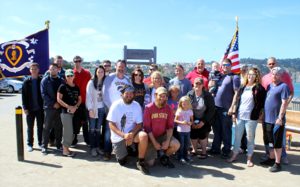
You mentioned how tough the walk was, were any states harder to walk?
(Trevor): Harder states were West Virginia by the Appalachian Mountains during the winter time. Utah was so hot I had some symptoms. I had a breakdown. Almost quit it but did not. We decided from Utah to Nevada we would walk before the sun came up.
I Lost three toenails during the walk. I wasn‘t paying attention to my body and there were days where I had heat exhaustion and dry heaving. In Nebraska, we went to see a memorial/statue and had a full body cramp. I had to get IV fluids at the VA hospital. I was still affected badly by the walk even though I was still one of the best hikers because of my experience. My Shoes were wearing out. I Had to be in a hotel for three days, had blisters, and could not walk at all. We believed our feet were gonna harden up.
How did you both feel when you finally made it to San Francisco, ending the walk?
(Trevor): Once we made it to Baker Beach, San Francisco, We definitely had mixed feelings. We were actually ahead of the scheduled timeline we made. Purple Heart Foundation had set up a little get together party for our family and friends to come to San Francisco and to celebrate with us. We couldn't believe that we made it. I remember Matt was looking over Alcatraz and taking videos of the view. That night we had a party and hung out with everyone and had a good time, walking near the ocean. We went to a bar and watched the Iowa vs Iowa State football game.
(Matt):We were so tired to comprehend that we made it. I Couldn't believe that we lived this lifestyle for such a long time and it was coming to an end. It took us 6 months and two weeks to walk across America. We started the walk on March 1st, 2018 and finished September 8th, 2018. 191 days and 3105 miles. We did not necessarily lose much weight because we were not eating the best foods while the trip occurred.
“The people helping us the most and the biggest supporters all had a military connection, whether a veteran or a military family.”
Would you do the Walk all over again?
(Matt): Now I think neither of us could handle it now. We have really thought about it for a couple of months, we want to drive through the entire trail in a car and try to see the people we met. I tell you the experience was worth it and the freedom of being outside.
We remember that you both had plans after this, we wanted to know how are you guys and what you have been up to?
(Matt): I Went to New York and became a technician and then went to paris. Staying in France for a little long but I’m thinking of coming to the U.S. but I am not sure of it. Bringing up the Walk Across America looking for a job actually has helped me in the job interviews.
(Trevor): I will be graduating soon and plan to find a job with the national parks service as a ranger.
Congratulations on your impending graduation. Is there anything you would like to share with anyone reading this?
(Both): Keep on going and help support the programs . The money is going to good places when you donate with the Purple Heart Foundation, and I remember how they helped my friends, they make sure that it goes to the right people in need of the help.
Vietnam Veteran to High School History
We all wonder where life will take us, he never wondered, he knew. John Harrison, a sophomore student at North Carolina University, wanted to fly helicopters but the only way he was able to, was by joining the Army. Not many would jump at the idea of joining the military, but he did… just to fly helicopters. Growing up he had a great childhood, a loving family and no regrets. With a clear vision in mind and the love for helicopters in heart, he pressed on with the hopes of making a difference.
It didn’t take long for John to get through Basic Combat Training, pass all qualifications and tests at Ft. Polk, L.A. and confidently begin his service in the United States Army, something he had aspired to do for so long. The transition from civilian to soldier was not an easy one though; it was divided into three parts…
- “The RED phase” is the beginning of your training, to prepare you for what’s to come.
- “The WHITE phase” is where he got most of the physical and psychological strength.
- “The BLUE phase” taught him how to handle weapons.
During the first several months in the military, John really enjoyed his time with fellow soldiers and instructors who only had “Tough love” for him. Since he had prepared well for the Army he was in great shape to withstand just about anything, even though he recalls the weather being too hot. It was so unbearably hot in Vietnam that they would drink 4 to 5 gallons of water, every day.
Many would be surprised how John expresses his take on joining the army, but this experience changed his life, his points of view, and his whole being. In the military you can train and prepare as much as possible, but nothing is like experiencing the challenges and traumas of combat than real life. John went to Officer Candidate School later, where he became Airborne Rifle Platoon Leader and Company Executive Officer.
Not long after, his unit was deployed to Vietnam on a USNS (United States Naval Ship). John joked, that although his accommodations on that ship weren’t great, the food was the best part. Since the ship was old, they had to stop at an island in the Philippines for repairs. While on the island, many of them stayed late in a club and almost ended up getting killed! Then after leaving the island, they came across the end tag of a typhoon and many were having trouble keeping their food down.
Finally, they reached Vietnam. They were told they would be safe because they were being protected by South Korea. One of the scariest and most unexpected moments in Vietnam was the first time he got shot at while walking in the mountains with his platoon. John thought to himself that he had been around shooting ranges so it wouldn’t be such a big deal…but as they kept taking on fire, he felt dumbfounded, he didn’t react, he didn’t really know what to do in that moment. The firefights in Vietnam were nothing like they had trained for.
John lasted 4 years in the Army, and said that it was nothing like he had expected. The military can train you so much, but you will never be completely ready to fight when it comes down to it. He was awarded the Purple Heart medal, because he was wounded during his service in Vietnam. He is thankful every day for not ever being captured as a prisoner of war (POW) and for being able to come home to his family. John retired from the military and went back to school to study Law. He became a well-known attorney and realtor in the Washington-Metropolitan Area. Later he went on to teach law at Bishop Denis J. O’Connell High School where he said he truly enjoyed his time with his students and learned a lot from their different opinions.
Now John enjoys his time traveling, being at home and just enjoying life. He has published two (2) books, in which he narrates his life experiences in Vietnam. From one’s first impression of John though, you wouldn’t think he was a veteran or picture him in the dangerous settings he described to me today. One thing is for sure though, John Harrison is and always will be, “Army Strong”.
Servicemen and Service Dogs: A Life Saving Connection
Our servicemen and women have to restart their lives upon returning home from battle. These new challenges can present circumstances far different from those of war. Facing these challenges head on can be daunting for many. Easing back into society can tough, especially for those who suffer from Post-Traumatic Stress (PTS) and Traumatic Brain Injury (TBI). According to the Veterans Administration (VA), between 11-20% of veterans during Operations Iraqi Freedom (OIF) and Enduring Freedom (OEF) have been diagnosed with PTS in a given year.
There are a variety of ways to ensure that transition is as smooth as possible. One of those methods is pairing a Veteran with a service dog. Suffering from PTS can leave an individual feeling isolated from family and friends. Depression and other emotional disorders can surface as well. The method of service dogs is to provide the veteran with a companion trained to help them with basic needs. However, the animal is indirectly re-teaching the veteran how to care for someone, using emotions as communication, and even how to love.
“We think pet dogs, therapy animals and service animals all have a role to play in peoples’ health and veterans’ health. This is all good news. A cold nose is a powerful motivation to get up in the morning,” said Stave Feldman, executive director of the Human Animal Bond Research Institute Foundation. Mr. Feldman discussed studies between the animals and veterans to The Military Times in a recent article.
“He brought me back from the brink,” said Veteran Colonel Roger Lintz, (US Army – Retired) of his Service Dog – Niles. Living with PTS does take time to accept that life may not be the same. This veteran, who honorably served his country, was able to find true companionship with his new four legged friend. Niles was able to help him with remedial tasks around the house and would wake him from nightmares. These nightmares and other issues with PTS nearly became too much to handle. Col. Lintz believes that his companion saved his life when suicidal thoughts started to cloud his mind. Watch the full interview:
The American Psychology Association and The Society Military Psychology have found that this alternative method could help nearly 40% of veterans. Especially those who do not show signs of improvement after participating in treatments such as prolonged exposure (PE) and cognitive processing therapy (CPT), which are considered the “gold standard” for treating PTS.
Maj. Todd Olsen had participated in multiple tours of duty since enlisting in the Army in 1989. However, coming back after his last mission sent his life into a tailspin. He was suffering from multiple symptoms of PTS, rebuilding a relationship with his two boys, and filing for divorce from his wife.
Some servicemen and women will attend the actual trainings with their service dog. They get to watch them go through obstacle courses, learn commands, and how to save lives. This, in a way, gives the veteran a sense of purpose again. Their life and bond matter as much to the service dog as the service dog means to them.
Maj. Todd Olsen of Pennsylvania told The Daily Progress that, “It’s not so much training the dog, it’s training the veteran and then pairing them up together. So we weren’t teaching them basic obedience, we were learning the commands and the dogs were learning how we give the commands.”
There have been few in-depth studies about the dynamic between a service dog and PTS. However, The Veterans Administration believes that veterans can experience some needed benefits by owning an animal or being paired with a service dog. The VA also counsels that veterans should speak with their doctor and family before applying for a service dog.
What are the emotional benefits of having a dog?
Dogs can make great pets. Having a dog as a pet can benefit anyone who likes dogs, including people with PTS. For example, dogs:
-
Help bring out feelings of love
-
Do things that are different from natural dog behavior
-
Do things that the handler (dog owner) cannot do because of a disability
-
Learn to work with the new handler in ways that help manage the owner’s disability
-
Are good companions
-
Take orders well when trained. This can be very comfortable for a Servicemember or Veteran who was used to giving orders in the military
-
Are fun and can help reduce stress
-
Are a good reason to get out of the house, spend time outdoors, and meet new people
(Source: The Veterans Administration)
Maj. Todd Olsen continues his transition into “civilian life” by working with his service dog and attending yoga classes. He says, “With the yoga for veterans and the dog, and continuing treatment at the VA, it’s putting me back together.”
The Purple Heart Foundation has provided funds to service dog programs totaling $75,000 over the years. The Purple Heart Foundation remains committed to assisting veterans in all aspects of their lives, including service dog programs, other rehabilitative programs, and disability benefits. You can show your support for these brave men and women who have sacrificed so much for our country by making a one-time or monthly pledge to ensure veterans continue to get the support and benefits they deserve by clicking here.
Giving Thanks for Freedom this Thanksgiving
Thanksgiving is a time to look back on the year gone by and reflect what you are thankful for. Thankfulness can come in many forms–having a new job, being able to provide for your family, or keeping friendships alive. For Americans, we have an extra reason to be thankful. Men and women in uniform working overseas and domestically make it possible for us to live in a free country.
For those who are overseas during the Thanksgiving holiday, the feeling can be bittersweet. Some are in war-torn areas fighting the enemy and most are away from the comforts of home and their families. There have been 152 recognized Thanksgiving holidays since its inception and despite being in unfamiliar territory, the armed forces have tried to make Thanksgiving as normal as possible for those deployed.
Even though the first nationally recognized Thanksgiving was not observed by the military because of a shortage of resources, over the years, there has been a push to have a Thanksgiving meal, regardless of where a service member is stationed. This food is usually gathered starting in May and sent out with the temperature-controlled food taking up to three months to reach its destination.
According to the Department of Defense, this is how much food was shipped out to various military bases across the world to prepare for a Thanksgiving feast last year:
-
51,699 pounds of turkey
-
25,970 pounds of beef
-
17,130 pounds of ham
-
706 gallons of eggnog
-
3,360 pounds of marshmallows
That is the equivalent to:
-
17 adult female hippos
-
14 1/2 Smart cars
-
24 male zebras
-
45 1/2 full kegs of beer
-
122 gold bars
The gathering of food doesn’t just stop at traditional holiday fare either. The Oak Lawn Park district in Illinois held its 6th annual Treats for Troops drive to send leftover and extra Halloween candy to those serving overseas.
While having a hot dinner can help stave off the feeling of homesickness during the holiday season, physically being with family and friends can make the holidays that much better. Spencer Girard, a seaman stationed in Norfolk, VA won a “Happy ThanksGathering” lottery to be the only person out of all the sailors and Marines stationed to be reunited with his family for the holiday. Katherine Girard said she hadn’t seen her son in a year and a half and being with him for the holidays last November was extra special, “The way they did it was just … oh my goodness. I didn’t know Norfolk was the world’s largest naval station, but you see when you get there. They spent a huge amount of money to treat everyone to a great Thanksgiving.”
On November 5, 2016, in the Albuquerque Convention Center while being welcomed back with the 126th Military Police Company from the Middle East, Specialist Rene Lopez held her daughter Amaya as her husband Specialist Jassen Lopez looked on. The couple were deployed to Kuwait together and left their four children, ages 3 to 8, in the care of family.
“Thanksgiving has come early to the people of the state of New Mexico,” Brigadier General Andy Salas, the state Guard’s adjutant general, told the crowd. The 120 soldiers who performed custom inspections-type work in maritime ports and airports across different parts of the Middle East wasn’t due back to the United States until January.
Kristen Smith, an Army wife, understands the changing nature of spending the holidays with someone in the military. Last year, she recalled how different the past 11 Thanksgivings have been with, and without, her husband. Thanksgiving celebrations varied greatly from sitting on the couch with her son watching movies to finally having her husband home last year for a “shockingly normal holiday.” For Smith, having such different variations of celebrating the Thanksgiving holiday has helped her be grateful in a way that she “could never have understood 12 years ago.”
During this holiday season, and every season, we are thankful for the work our troops do overseas so we can enjoy the freedom we have today. The Purple Heart Foundation is committed to assisting veterans in all aspects of their lives, including helping those who are in need of assistance while transitioning home from the battlefield. You can show your support for these brave men and women who have sacrificed so much for our country by making a one-time or monthly pledge to ensure veterans continue to get the support and benefits they deserve by clicking here.
Sgt. Dorsey: The wallet that saved my life!
On Aug. 14, 1937, Mrs. Elizabeth Dorsey gave her youngest son, Raymond, a leather wallet as a present on his 16th birthday; she never knew that wallet would save her son’s life in WWII.
Raymond Dorsey joined the 22nd Infantry of the 4th ID a few weeks before Christmas. “We were in the Hürtgen Forest of Germany during the Battle of the Bulge. There was lots of snow, and it was so cold the soldiers had to take socks and other clothing off the dead to keep warm” – these memories still haunt Mr. Dorsey to this day.
“If it wasn’t the Germans trying to kill us it was the weather. I fought through the Bulge until mid-January of ’45 when it was over. This is when the prisoners started turning themselves in – they were glad to be out of it. There were more of them than there were of us, but the fighting was over, and they were surrendering. Middle of Jan ’45 – my outfit started to receive a lot of German prisoners. I had to line them up and search them. They all had a wallet full of German money, which was worthless to them now – there was nothing for them to buy, nowhere they could spend it – but I didn’t have any money. I traded them anything I could give them for their money. I ended up with so much of their money – my wallet was so full I couldn’t carry it in my back pocket, like normal, so I moved it to my shirt front pocket. We took artillery fire during the fighting at the Bulge and up until this time I had several close calls – yet was never hit.
We were later moved to the city of Prüm, Germany, on Feb 14, 1945 – we were told to set up a staging area at the edge of town. The enemy was waiting to hit us until the late evening; dropping shells all around us. We had to set up a command post in a house with two medics setup in the basement. I was on guard duty when the Germans dropped a shell real close. I was a little way away from the house and hadn’t been hit, so after those shells dropped, I moved closer to the house to find some cover. I took one step into the house and when I turned around a shell landed right in front of me… and that’s when my lights went out. The fat leather wallet in my shirt pocket, now over my heart, caught the main hit of shrapnel. I was unconscious and the medics helped save me by stopping the bleeding.
When I came to, I was on the floor of a big building, maybe an airplane hangar. From what I could see, the whole floor was covered with soldiers like myself – just full of soldiers like me. I wanted a drink of water – they wouldn’t give it to me, but they did give me a shot of morphine. I hadn’t had a shave or bath since I’d arrived. I must have been a sight! I don’t know how long I was there or where it was – they kept me knocked out. They loaded me into an ambulance, and I remember I heard them say we were passing the Eiffel Tower, so we must have been in Paris at this time. When I woke up next – I woke up bathed, shaved and in a clean bed with sheets. I don’t know how long I was in France. All I remember next is waking up in a hospital in England and being handed my belongings, the wallet included; only this time it was full of American money – someone had changed all the German money for American! I felt blessed because there was enough money in my wallet to send $100 to my wife (which was a lot of money in 1945) and I kept the rest.
My right thigh was all bandaged up and they started to unwrap it. They later rolled me outside for a long way to the operating room – that’s when they sewed up my leg wound and put it in a cast. When the cast was removed, my doctor came around and asked, “how are you doing today soldier?” I said “well, they just removed my cast, but I can’t move my knee.” He went to the bottom of my bed, grabbed my right foot and gave it a heave – like a pistol shot, you could hear it – but after that I could bend my knee again. I can still see shrapnel in my thigh, my ankle and I’ve got a little in my face around my left eye. My buddies in the hospital though were the ones to point out there was a hole in my wallet, that’s when I realized that the wallet my mother gave me on my 16th birthday is what saved my life that night in Germany!”
Sgt. Dorsey was never able to tell his mom that she had saved his life with her birthday gift. When he was medically fit to be sent home, he learned his mother was terminally ill. Sgt. Dorsey told us “I was able to see my mom just before she passed, as I’d finally been released – she was a good mother. I didn’t talk to her about the war, never showed the wounds; it was too soon, and people didn’t want to know. I still have to live with it.”
Veterans and Purple Heart recipients like Sgt. Dorsey did not only help shape history, they carry their own part of history with them, just waiting to impart their stories, experiences and wisdom on others. The next time you come across a veteran, take a moment to listen and you may be amazed at the incredibly heroic, selfless, and in cases like this…miraculous stories that nobody else knows about. One VA Center nurse took the time to not only listen to her patient, but to send the Purple Heart Foundation a written recount of Sgt. Dorsey’s story to share with all of you! Join us in saluting Mr. Dorsey for his service and sacrifice!
The Purple Heart Foundation provides various programs and assistance that supports our veterans and their families. The Purple Heart Foundation is committed to assisting veterans, and their caregivers, in all aspects of their lives, including helping those who need assistance while transitioning from the battlefield to the home front. You can show your support for these brave men and women who have sacrificed so much for our country by making a one-time or monthly pledge to ensure veterans continue to get the support and benefits they deserve.
Daniel Prigge: Surviving the Hits
The Purple Heart Foundation connects with Purple Heart recipients to share their unforgettable stories of valor. Here on the Purple Heart Foundation blog, you will read about the personal experiences of some of our heroes. These veterans have proudly served and sacrificed to protect our nation. Daniel Prigge is one of them…he is lucky to be alive, and proud to share his story to inspire others to keep carrying on.
“My name is Daniel Prigge, I served a little over 10 years in the US Army. I was wounded on May 03, 2011. My vehicle was struck by three EFP roadside bombs. My convoy was hit with a total of five EFP’s and one EFP that did not go off. My truck was also hit by an RPG and small arms fire during the ambush.
I was on a small fourteen-man team that was PSD (Protective Service Detail) for the general in charge of the pull out of Iraq. On May 2nd, the general took a helicopter flight to a meeting right outside of Baghdad, Iraq. The next day, my team was on the way to pick him up and bring him back to our FOB (Forward Operating Base). We were on the outskirts of Baghdad on a route that had a fence line on the left side and a canal on the right side. We were using RG33L trucks – a mine-resistant light armored vehicle built longer than the RG-33 to hold twice as many people – due to how many people we would have to escort from place to place. We were traveling down the route when suddenly I see an RPG hit the front of my truck…seconds later I felt an explosion to the left side of my vehicle.
I was the truck commander of the convoy, I was knocked out from the explosion and had sustained injuries of a shifted spine, both knees completely blown out and dislocated, left hemiparesis, broken nose, intestinal problems, brain leakage as well as shrapnel hitting my eye and destroying my optic nerve.
After the explosion, our convoy was still under fire. I looked at the vehicle behind me and saw that the truck was burning on fire with my guys inside. Our coms were not working due to the explosion, I came-to, dismounted the truck and directed four guys including myself to bound in teams of two back to the burning vehicle. The burning vehicle was about three hundred meters behind us. The first and second truck in the convoy were not able to turn around and get us out of the kill zone due to the fence and the canal on the route. My team bounded three hundred meters and helped get the other guys on the team out of the burning vehicle. We were still under contact, but by this time we received help from the Iraqi Special Operations unit. We finally secured the kill zone about fifteen minutes into the fire fight.
I took off my helmet and that is when the back of my head swelled up. I wasn’t aware that the entire time, my helmet was acting as a make-shift compression bandage. So, once I took the helmet off, my head expanded, and I passed out on the ground next to an Iraqi Army truck. Due to the unexploded ordinance still hot in the kill zone it took the MEDEVAC helicopter three hours to land to take the wounded to the nearest FOB. I went through over fifty surgeries including back surgery, six knee surgeries to put cadavers and to put my tibia and fibula back together. My fibula is cut in half due to it completely dislocating.
I retired from the Army in 2015 and now own a Max Muscle Sports Nutrition store in Green Bay, Wisconsin. My awards include Iraqi Campaign Medal with two campaign stars, Army commendation Medal (4th award), Purple Heart (2nd award), Army Achievement Medal, Army Good Conduct Medal (3rd Award), National Defense Medal, Global War on Terrorism Medal, Army Service Ribbon, Combat Infantry Badge, Expert Infantry Badge, Ranger Tab, Parachutist Badge, CLS, Combatives level 3 and Tiger Swan qualified.“
Daniel Prigge, US Army, Retired, Purple Heart Recipient
To help the Purple Heart Foundation continually provide programs, services, scholarships and other opportunities to veterans like Daniel Prigge, make a donation today.
JP Lane's Short Story
JP Lane’s Short Story – Purple Heart Veteran
My name is Justin Lane, aka JP Lane. Many people have their own reasoning for joining the military, mine is probably similar to most my age, in 2001, watching the twin towers fall. I was reminded of that feeling when I was old enough to sign up. At the age of 20, In 2008, I joined the U.S. Army as a Combat Engineer. I was deployed, in 2010, to Afghanistan to search for IED’s (Improvised Explosive Devices). I was blown up 3 separate times, and the 3rd one got me. July 2nd, 2011, I was blown up by a 200lb IED while on mission. It was the first IED to penetrate an RG31 truck. The blast resulted in putting me in a coma for 6 weeks. I lost both my legs, right arm snapped in half, lost my four front teeth, pelvis snapped in half, spine dislocated from my pelvis, and everything in my torso was destroyed by shrapnel except for my heart and left lung. In total, I received 26 injuries, and had 28 surgeries, this completely changed my life. Doctors said I wasn’t going to be able to do many things, like, use prosthetics because my legs were so badly damaged. Also, that I wouldn’t be able to speak properly or sing ever again because of a tracheotomy.
With each day, I am proving them wrong. I am the only double amputee recording artist in the world. God wasn’t finished with me yet. Since I got my prosthetics, I have performed for 2 Presidential Inaugurations, Presidents Obama and Trump. I have performed with Lee Greenwood, Neil McCoy, Aaron Tippin, Jason Castro, and more. I have performed for non-profit organizations such as Adopt-a-Vet and Helping a Hero, which are in support of our military. I also, performed for organizations that support the local community, like, “Taking it to the Streets”, a homelessness initiative, and G.A.N.G Outreach in Colorado, that provides positive/encouraging sports camps for underprivileged kids. I have also been able to perform and inspire thousands in Brazil and Mexico. I signed the dotted line when I joined the Army – to SERVE and protect the American people – and since I am still alive, by the grace of God, I will continue to serve. Retirement is just a word! So, I decided to be a motivational speaker to share my story and give hope to those who need it. I am a reminder for others to “Never Give Up, Never Surrender”.
My goal is to impact the world with more than just music. Changing hearts and minds, one at a time.
In a situation like mine, most people would look in the mirror and feel like no one would want them. I was blessed to have found someone who not only loves me for me, but also supports my career and my passion of singing. Crystal, my beautiful wife as of Feb. 2018, has been a huge support for me and given my life purpose. We now work together inspiring couples around us, telling them the amazing story of what brought us together.
April 1st – 9th, I went back to AFGHANISTAN to have a “proper exit.” I was able to visit the hospital I was first recovering in after being blown up. Since I was in a coma, I did not remember much of the hospitals or traveling that I did during that time. As I visited different bases around Afghanistan, I was welcomed back with open arms from thousands of troops. I was proud to walk down the welcome ceremonial row, holding my “NICE TRY TAILBAN” shirt. One of the most amazing feelings was getting to wear the U.S. Army uniform once again, but nothing compared to the feeling of getting to leave the country on my own two feet, prosthetic feet, with my head held high!
Upon returning from Afghanistan, just as it seemed like my story was about to end, Crystal and I were in a serious car accident that rolled our jeep and destroyed our car. Airbags went off in every direction, and glass shattered with every turn of our vehicle. Thank God we were wearing our seat belts, otherwise the damage we received would have been worse. But as part of the strong and determined Lane family, we will overcome. Nothing in this world will defeat us or bring us down! We have a purpose… to bring hope, love, inspiration and the idea of being mentally strong, to people across the world.
